Comparative Accuracy Assessment of Unmanned and Terrestrial Laser Scanning Systems for Tree Attribute Estimation in an Urban Mediterranean Forest
Highlights
- Semi-automatic ULS processing (CloudCompare/ArcMap) produced more accurate DBH than the fully automatic Spatix workflow across the urban park.
- TLS provided the most accurate DBH when compared with ground-based measurements (TGBM); ULS produced slightly higher and more uniform tree height estimates.
- For urban forest inventories, TLS is preferable for DBH estimation.
- A hybrid workflow combining ULS with personal/mobile laser scanning (PLS; SLAM-based) can reduce occlusion, increase completeness, and improve overall accuracy in heterogeneous urban canopies.
Abstract
1. Introduction
2. Materials and Methods
2.1. Study Area and Traditional Ground-Based Measurement (TGBM) Method
2.2. Unmanned Laser Scanning (ULS) Data
2.2.1. ULS Data Collection
2.2.2. ULS Data Processing Using Fully Automatic Workflow
2.2.3. ULS Data Processing in CloudCompare (CC)—Semi-Automatic Workflow
2.3. Terrestrial Laser Scanning (TLS)
2.3.1. TLS Data Collection
2.3.2. TLS Data Processing
2.4. Accuracy Assessment of Data Acquisition Methods and Software
3. Results
3.1. Level 1 (The Entire Park Area)—Accuracy Assessment of ULS-Based DBH Estimates Derived from Fully Automatic and Semi-Automatic Processing Workflows Compared to TGBM
3.2. Level 2 (The Subsampled Park Area)
3.2.1. Accuracy Assessment of ULS- and TLS-Based DBH Estimates Derived from Fully Automatic (Spatix) Processing Workflow: Comparison with the TGBM Method
3.2.2. Comparison of ULS- and TLS-Based Tree Height Estimates Automatically Processed in Spatix
4. Discussion
4.1. Comparison of ULS-Based DBH Estimates Derived from Fully Automatic and Semi-Automatic with the TGBM Method
4.2. Comparison of ULS- and TLS-Based DBH Estimates Derived from Fully Automatic Processing Workflow with the TGBM Method
4.3. Comparison of Automatically Derived ULS- and TLS-Based Tree Height Estimates
4.4. Future Perspectives
4.5. Limitations of the Study
5. Conclusions
Author Contributions
Funding
Data Availability Statement
Acknowledgments
Conflicts of Interest
Abbreviations
| TLS | Terrestrial Laser Scanning |
| ULS | Unmanned Laser Scanning |
| PLS | Personal Laser Scanning |
| TGBM | Traditional Ground-Based Measurement |
| CC | CloudCompare |
| SLAM | Simultaneous Localization and Mapping |
| DBH | Diameter at Breast Height |
| SD | Standard Deviation |
| RMSE | Root-Mean-Square Error |
| CCC | Concordance Correlation Coefficient |
Appendix A
| ID | TLS | ULS | Mean (TLS+ULS/2) | Diff. (TLS-ULS) | Rel. Diff. (∣TLS-ULS∣)/((TLS+ULS)/2) × 100 |
|---|---|---|---|---|---|
| s62 | 3.64 | 3.91 | 5.60 | −0.27 | 7.15 |
| s66 | 4.6 | 5.31 | 7.26 | −0.71 | 14.33 |
| s63 | 4.1 | 4.11 | 6.16 | −0.01 | 0.24 |
| s67 | 4.67 | 3.53 | 6.44 | 1.14 | 27.94 |
| s55 | 5.4 | 6.09 | 8.45 | −0.69 | 12.07 |
| s54 | 4.64 | 6.8 | 8.04 | −2.16 | 37.72 |
| s12 | 4.97 | 6.26 | 8.10 | −1.29 | 23.20 |
| s51 | 6.85 | 6.4 | 10.05 | 0.45 | 6.84 |
| s65 | 6.45 | 7.06 | 9.98 | −0.61 | 8.99 |
| s57 | 4.45 | 17.25 | 13.08 | −12.8 | 119.34 |
| s56 | 6.82 | 18.29 | 15.97 | −11.47 | 91.48 |
| s61 | 8.94 | 9.67 | 13.78 | −0.73 | 7.83 |
| s64 | 16.69 | 16.91 | 25.15 | −0.22 | 1.31 |
| s68 | 16.5 | 5.71 | 19.36 | 10.79 | 93.18 |
| s58 | 18.66 | 11.93 | 24.63 | 6.73 | 43.92 |
| s60 | 8.63 | 10.06 | 13.66 | −1.43 | 15.59 |
| s59 | 19.29 | 12.13 | 25.36 | 7.16 | 45.99 |
| s69 | 15.54 | 15.74 | 23.41 | −0.2 | 1.28 |
References
- Šiljeg, S.; Marić, I.; Nikolić, G.; Šiljeg, A. Accessibility analysis of urban green spaces in the settlement of Zadar in Croatia. Šumarski List 2018, 142, 487–496. [Google Scholar] [CrossRef]
- Jones, B.A. Planting urban trees to improve quality of life? The life satisfaction impacts of urban afforestation. For. Policy Econ. 2021, 125, 102408. [Google Scholar] [CrossRef]
- World Health Organization (WHO). Urban Green Spaces: A Brief for Action; WHO: Copenhagen, Denmark, 2017; Available online: https://iris.who.int/bitstream/handle/10665/344116/9789289052498-eng.pdf (accessed on 13 December 2024).
- Biernacka, M.; Kronenberg, J. Urban green space availability, accessibility and attractiveness, and the delivery of ecosystem services. Cities Environ. (CATE) 2019, 12, 5. [Google Scholar] [CrossRef]
- Orlandi, F.; Fornaciari, M.; Ranfa, A.; Proietti, C.; Ruga, L.; Meloni, G.; Burnelli, M.; Ventura, F. LIFE-CLIVUT, ecosystem benefits of urban green areas: A pilot case study in Perugia (Italy). iforest-Biogeosci. For. 2022, 15, 133. [Google Scholar] [CrossRef]
- Kothencz, G.; Kolcsár, R.; Cabrera-Barona, P.; Szilassi, P. Urban green space perception and its contribution to well-being. Int. J. Environ. Res. Public Health 2017, 14, 766. [Google Scholar] [CrossRef] [PubMed]
- Tyrväinen, L.; Pauleit, S.; Seeland, K.; De Vries, S. Benefits and uses of urban forests and trees. In Urban Forests and Trees: A Reference Book; Konijnendijk, C.C., Nilsson, K., Randrup, T.B., Schipperijn, J., Eds.; Springer: Berlin/Heidelberg, Germany, 2005; pp. 81–114. [Google Scholar] [CrossRef]
- Nardi, P.; Di Matteo, G.; Palahi, M.; Scarascia Mugnozza, G. Structure and evolution of Mediterranean forest research: A science mapping approach. PLoS ONE 2016, 11, e0155016. [Google Scholar] [CrossRef] [PubMed]
- Ostoić, S.K.; Salbitano, F.; Borelli, S.; Verlič, A. Urban forest research in the Mediterranean: A systematic review. Urban For. Urban Green. 2018, 31, 185–196. [Google Scholar] [CrossRef]
- Jorgensen, E. Urban forestry in the rearview mirror. Arboric J. 1986, 10, 177–190. [Google Scholar] [CrossRef]
- Scholz, T.; Hof, A.; Schmitt, T. Cooling effects and regulating ecosystem services provided by urban trees—Novel analysis approaches using urban tree cadastre data. Sustainability 2018, 10, 712. [Google Scholar] [CrossRef]
- Noe, N.; Massi, F. Urban Forest Digital Cadastre. J. Civ. Eng. Archit. 2021, 15, 330–341. [Google Scholar] [CrossRef]
- Lupp, G.; Förster, B.; Kantelberg, V.; Markmann, T.; Naumann, J.; Honert, C.; Pauleit, S. Assessing the recreation value of urban woodland using the ecosystem service approach in two forests in the Munich metropolitan region. Sustainability 2016, 8, 1156. [Google Scholar] [CrossRef]
- Nowak, D.J.; Crane, D.E. Carbon storage and sequestration by urban trees in the USA. Environ. Pollut. 2002, 116, 381–389. [Google Scholar] [CrossRef] [PubMed]
- Alvey, A.A. Promoting and preserving biodiversity in the urban forest. Urban For. Urban Green. 2006, 5, 195–201. [Google Scholar] [CrossRef]
- Jones, B.A.; McDermott, S.M. Health impacts of invasive species through an altered natural environment: Assessing air pollution sinks as a causal pathway. Environ. Resour. Econ. 2018, 71, 23–43. [Google Scholar] [CrossRef]
- Panagiotidis, D.; Abdollahnejad, A.; Slavík, M. 3D point cloud fusion from UAV and TLS to assess temperate managed forest structures. Int. J. Appl. Earth Obs. Geoinf. 2022, 112, 102917. [Google Scholar] [CrossRef]
- Balenović, I.; Alberti, G.; Marjanović, H. Airborne laser scanning-the status and perspectives for the application in the south-east European forestry. South-East. Eur. For. SEEFOR 2013, 4, 59–79. [Google Scholar] [CrossRef]
- Sakari, T.; Juho, P.; Andras, B.; Pekka, H.; Eero, M. NFI plots as complementary reference data in forest inventory based on airborne laser scanning and aerial photography in Finland. Silva Fenn. 2014, 48, 983. [Google Scholar] [CrossRef]
- Liang, X.; Kukko, A.; Balenović, I.; Saarinen, N.; Junttila, S.; Kankare, V.; Holopainen, M.; Mokroš, M.; Surový, P.; Kaartinen, H.; et al. Close-range remote sensing of forests: The state of the art, challenges, and opportunities for systems and data acquisitions. IEEE Geosci. Remote Sens. Mag. 2022, 10, 32–71. [Google Scholar] [CrossRef]
- Balenović, I.; Liang, X.; Jurjević, L.; Hyyppä, J.; Seletković, A.; Kukko, A. Hand-held personal laser scanning–current status and perspectives for forest inventory application. Croat. J. For. Eng. J. Theory Appl. For. Eng. 2021, 42, 165–183. [Google Scholar] [CrossRef]
- Wu, Y.; Zhong, S.; Ma, Y.; Zhang, Y.; Liu, M. Application of SLAM-Based Mobile Laser Scanning in Forest Inventory: Methods, Progress, Challenges, and Perspectives. Forests 2025, 16, 920. [Google Scholar] [CrossRef]
- Ayrey, E.; Hayes, D.J.; Kilbride, J.B.; Fraver, S.; Kershaw, J.A.; Cook, B.D.; Weiskittel, A.R. Synthesizing disparate LiDAR and satellite datasets through deep learning to generate wall-to-wall regional inventories for the complex, mixed-species forests of the eastern United States. Remote Sens. 2021, 13, 5113. [Google Scholar] [CrossRef]
- Chen, Q.; Gao, T.; Zhu, J.; Wu, F.; Li, X.; Lu, D.; Yu, F. Individual tree segmentation and tree height estimation using leaf-off and leaf-on UAV-LiDAR data in dense deciduous forests. Remote Sens. 2022, 14, 2787. [Google Scholar] [CrossRef]
- Douss, R.; Farah, I.R. Extraction of individual trees based on Canopy Height Model to monitor the state of the forest. Trees For. People 2022, 8, 100257. [Google Scholar] [CrossRef]
- Bienert, A.; Hess, C.; Maas, H.G.; Von Oheimb, G. A voxel-based technique to estimate the volume of trees from terrestrial laser scanner data. Int. Arch. Photogramm. Remote Sens. Spat. Inf. Sci. 2014, 40, 101–106. [Google Scholar] [CrossRef]
- Fu, H.; Li, H.; Dong, Y.; Xu, F.; Chen, F. Segmenting individual tree from TLS point clouds using improved DBSCAN. Forests 2022, 13, 566. [Google Scholar] [CrossRef]
- Li, W.; Guo, Q.; Jakubowski, M.K.; Kelly, M. A new method for segmenting individual trees from the lidar point cloud. Photogramm. Eng. Remote Sens. 2012, 78, 75–84. [Google Scholar] [CrossRef]
- Yang, J.; Kang, Z.; Cheng, S.; Yang, Z.; Akwensi, P.H. An individual tree segmentation method based on watershed algorithm and three-dimensional spatial distribution analysis from airborne LiDAR point clouds. IEEE J. Sel. Top. Appl. Earth Obs. Remote Sens. 2020, 13, 1055–1067. [Google Scholar] [CrossRef]
- Latella, M.; Sola, F.; Camporeale, C. A density-based algorithm for the detection of individual trees from LiDAR data. Remote Sens. 2021, 13, 322. [Google Scholar] [CrossRef]
- Windrim, L.; Bryson, M. Detection, segmentation, and model fitting of individual tree stems from airborne laser scanning of forests using deep learning. Remote Sens. 2020, 12, 1469. [Google Scholar] [CrossRef]
- Luoma, V.; Saarinen, N.; Wulder, M.A.; White, J.C.; Vastaranta, M.; Holopainen, M.; Hyyppä, J. Assessing precision in conventional field measurements of individual tree attributes. Forests. 2017, 8, 38. [Google Scholar] [CrossRef]
- Trimble. Trimble R12i. Available online: https://geospatial.trimble.com/en/products/hardware/trimble-r12i (accessed on 13 December 2024).
- Wallace, L.; Lucieer, A.; Watson, C.S. Evaluating tree detection and segmentation routines on very high resolution UAV LiDAR data. IEEE Trans. Geosci. Remote Sens. 2014, 52, 7619–7628. [Google Scholar] [CrossRef]
- DJI. Support for Zenmuse L1. Available online: https://www.dji.com/hr/support/product/zenmuse-l1 (accessed on 13 December 2024).
- Hebel, M.; Stilla, U. Simultaneous calibration of ALS systems and alignment of multiview LiDAR scans of urban areas. IEEE Trans. Geosci. Remote Sens. 2011, 50, 2364–2379. [Google Scholar] [CrossRef]
- Spadavecchia, C.; Campos, M.B.; Piras, M.; Puttonen, E.; Shcherbacheva, A. Wood-Leaf Unsupervised Classification of Silver Birch Trees for Biomass Assessment Using Oblique Point Clouds. Int. Arch. Photogramm. Remote Sens. Spat. Inf. Sci. 2023, 48, 1795–1802. [Google Scholar] [CrossRef]
- ASPRS. The LAS 1.4 Specification. 2012. Available online: https://www.asprs.org/wp-content/uploads/2010/12/LAS_Specification.pdf (accessed on 7 April 2025).
- Dong, X.; Kim, W.Y.; Lee, K.H. Drone-based three-dimensional photogrammetry and concave hull by slices algorithm for apple tree volume mapping. J. Biosyst. Eng. 2021, 46, 474–484. [Google Scholar] [CrossRef]
- Šiljeg, A.; Marić, I.; Domazetović, F.; Cukrov, N.; Lovrić, M.; Panđa, L. Bathymetric survey of the St. Anthony channel (Croatia) using multibeam echosounders (MBES)—A new methodological semi-automatic approach of point cloud post-processing. J. Mar. Sci. Eng. 2022, 10, 101. [Google Scholar] [CrossRef]
- Domazetović, F.; Šiljeg, A.; Marić, I. A comprehensive framework for multiscale soil erosion modeling: A case study of Pag Island, Croatia. In Geographical Information Science; Elsevier: Amsterdam, The Netherlands, 2024; pp. 127–157. [Google Scholar] [CrossRef]
- Laino, D.; Cabo, C.; Prendes, C.; Janvier, R.; Ordonez, C.; Nikonovas, T.; Santin, C. 3DFin: A software for automated 3D forest inventories from terrestrial point clouds. For. An. Int. J. For. Res. 2024, 97, 479–496. [Google Scholar] [CrossRef]
- Compeán-Aguirre, J.L.; López-Serrano, P.M.; Silván-Cárdenas, J.L.; Martínez-García-Moreno, C.A.; Vega-Nieva, D.J.; Corral-Rivas, J.J.; Pompa-García, M. Evaluation of Two-Dimensional DBH Estimation Algorithms Using TLS. Forests 2024, 15, 1964. [Google Scholar] [CrossRef]
- Faro. FARO® FocusM 70 Laser Scanner, Short-Range Professional Grade Laser Scanner. 2016. Available online: https://www.laserscanning-europe.com/sites/default/files/redakteur_images/faro-focus-m-70-tech-sheet_0.pdf (accessed on 13 December 2024).
- Šiljeg, A.; Marić, I.; Cukrov, N.; Domazetović, F.; Roland, V. A multiscale framework for sustainable management of tufa-forming watercourses: A case study of National Park “Krka”, Croatia. Water 2020, 12, 3096. [Google Scholar] [CrossRef]
- Domazetović, F.; Šiljeg, A.; Marić, I.; Panđa, L. A new systematic framework for optimization of multi-temporal terrestrial LiDAR surveys over complex gully morphology. Remote Sens. 2022, 14, 3366. [Google Scholar] [CrossRef]
- Brede, B.; Lau, A.; Bartholomeus, H.M.; Kooistra, L. Comparing RIEGL RiCOPTER UAV LiDAR derived canopy height and DBH with terrestrial LiDAR. Sensors 2017, 17, 2371. [Google Scholar] [CrossRef] [PubMed]
- Olofsson, K.; Holmgren, J.; Olsson, H. Tree stem and height measurements using terrestrial laser scanning and the RANSAC algorithm. Remote Sens. 2014, 6, 4323–4344. [Google Scholar] [CrossRef]
- Weiser, H.; Schäfer, J.; Winiwarter, L.; Krašovec, N.; Fassnacht, F.E.; Höfle, B. Individual tree point clouds and tree measurements from multi-platform laser scanning in German forests. Earth Syst. Sci. Data 2022, 14, 2989–3012. [Google Scholar] [CrossRef]
- Singh, A.; Pavlenko, V.; Mokros, M. Tree parameter estimation with iPhone point cloud data using multiple algorithms. Int. J. Remote Sens. 2024, 45, 9443–9460. [Google Scholar] [CrossRef]
- Florea, S.C.; Dutca, I.; Nita, M.D. Tradeoffs and limitations in determining tree characteristics using 3D pointclouds from terrestrial laser scanning: A comparison of reconstruction algorithms on European bech (Fagus sylvatica L.) trees: A Case Study with European Beech (Fagus sylvatica). Ann. For. Res. 2024, 67, 185–199. [Google Scholar] [CrossRef]
- Liang, X.; Wang, Y.; Pyörälä, J.; Lehtomäki, M.; Yu, X.; Kaartinen, H.; Deng, S. Forest in situ observations using unmanned aerial vehicle as an alternative of terrestrial measurements. For. Ecosyst. 2019, 6, 20. [Google Scholar] [CrossRef]
- Zeybek, M. Semiautomatic Diameter-at-Breast-Height Extraction from Structure-from-Motion-Based Point Clouds Using a Low-Cost Fisheye Lens. Forests 2025, 16, 439. [Google Scholar] [CrossRef]
- Sheng, Y.; Zhao, Q.; Wang, X.; Liu, Y.; Yin, X. Tree Diameter at Breast Height Extraction Based on Mobile Laser Scanning Point Cloud. Forests 2024, 15, 590. [Google Scholar] [CrossRef]
- Panagiotidis, D.; Surový, P.; Kuželka, K. Accuracy of Structure from Motion models in comparison with terrestrial laser scanner for the analysis of DBH and height influence on error behaviour. J. For. Sci. 2016, 62, 357–365. [Google Scholar] [CrossRef]
- Kükenbrink, D.; Marty, M.; Bösch, R.; Ginzler, C. Benchmarking laser scanning and terrestrial photogrammetry to extract forest inventory parameters in a complex temperate forest. Int. J. Appl. Earth Obs. Geoinf. 2022, 113, 102999. [Google Scholar] [CrossRef]
- Liu, G.; Wang, J.; Dong, P.; Chen, Y.; Liu, Z. Estimating individual tree height and diameter at breast height (DBH) from terrestrial laser scanning (TLS) data at plot level. Forests 2018, 9, 398. [Google Scholar] [CrossRef]
- Wang, P.; Gan, X.; Zhang, Q.; Bu, G.; Li, L.; Xu, X.; Li, Y.; Liu, Z.; Xiao, X. Analysis of parameters for the accurate and fast estimation of tree diameter at breast height based on simulated point cloud. Remote Sens. 2019, 11, 2707. [Google Scholar] [CrossRef]
- Lee, Y.; Lee, J. Evaluation of accuracy in estimating diameter at breast height based on the scanning conditions of terrestrial laser scanning and circular fitting algorithm. Forests 2024, 15, 313. [Google Scholar] [CrossRef]
- Pueschel, P.; Newnham, G.; Rock, G.; Udelhoven, T.; Werner, W.; Hill, J. The influence of scan mode and circle fitting on tree stem detection, stem diameter and volume extraction from terrestrial laser scans. ISPRS J. Photogramm. Remote Sens. 2023, 77, 44–56. [Google Scholar] [CrossRef]
- Gollob, C.; Ritter, T.; Wassermann, C.; Nothdurft, A. Influence of scanner position and plot size on the accuracy of tree detection and diameter estimation using terrestrial laser scanning on forest inventory plots. Remote Sens. 2019, 11, 1602. [Google Scholar] [CrossRef]
- Nurunnabi, A.; Teferle, F.; Al-Sharadqah, A.; Xia, Y.; Hunegnaw, A. Robust estimation of tree diameter at breast height from point clouds. In Proceedings of the IEEE International Geoscience and Remote Sensing Symposium (IGARSS 2024), Athens, Greece, 7–12 July 2024; pp. 5284–5287. [Google Scholar] [CrossRef]
- Li, Z.; Qiao, Q.; Han, Z.; Liu, X.; Wang, Y.; Tang, H.; Deng, L. Terrestrial laser scanning in forestry: Accuracy and efficiency in measuring individual tree parameters. PLoS ONE 2025, 20, e0331126. [Google Scholar] [CrossRef]
- Li, L.; Mu, X.; Soma, M.; Wan, P.; Qi, J.; Hu, R.; Zhang, W.; Tong, Y.; Yan, G. An iterative-mode scan design of terrestrial laser scanning in forests for minimizing occlusion effects. IEEE Transactions on Geoscience and Remote Sensing 2020, 59, 3547–3566. [Google Scholar] [CrossRef]
- Bauwens, S.; Bartholomeus, H.; Calders, K.; Lejeune, P. Forest inventory with terrestrial LiDAR: A comparison of static and hand-held mobile laser scanning. Forests 2016, 7, 127. [Google Scholar] [CrossRef]
- Kuželka, K.; Marušák, R.; Surový, P. Inventory of close-to-nature forest stands using terrestrial mobile laser scanning. Int. J. Appl. Earth Obs. Geoinf. 2022, 115, 103104. [Google Scholar] [CrossRef]
- DJI Terra. Spatix-x64 v.025.003-r6648, DJI: Shenzhen, China, 2025.
- Liao, K.; Li, Y.; Zou, B.; Li, D.; Lu, D. Examining the role of UAV Lidar data in improving tree volume calculation accuracy. Remote Sens. 2022, 14, 4410. [Google Scholar] [CrossRef]
- Yang, S.; Xing, Y.; Xing, T.; Deng, H.; Xi, Z. Multi-sensors fusion SLAM-aided forest plot mapping with backpack dual-LiDAR system. IEEE J. Sel. Top. Appl. Earth Obs. Remote Sens. 2024, 17, 16051–16070. [Google Scholar] [CrossRef]
- Pan, D.; Shao, J.; Zhang, S.; Zhang, S.; Chang, B.; Xiong, H.; Zhang, W. Slam-based forest plot mapping by integrating imu and self-calibrated dual 3-d laser scanners. IEEE Trans. Geosci. Remote Sens. 2023, 61, 5703713. [Google Scholar] [CrossRef]

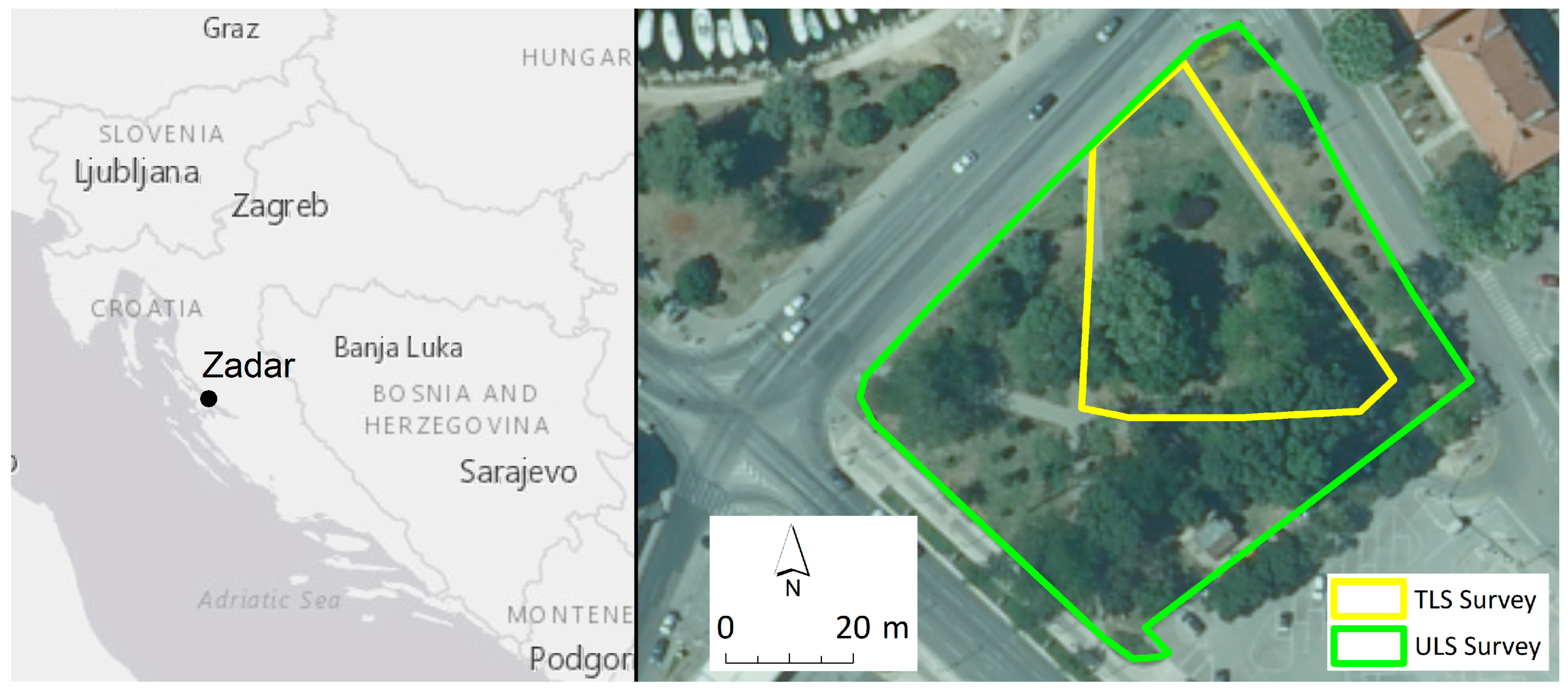
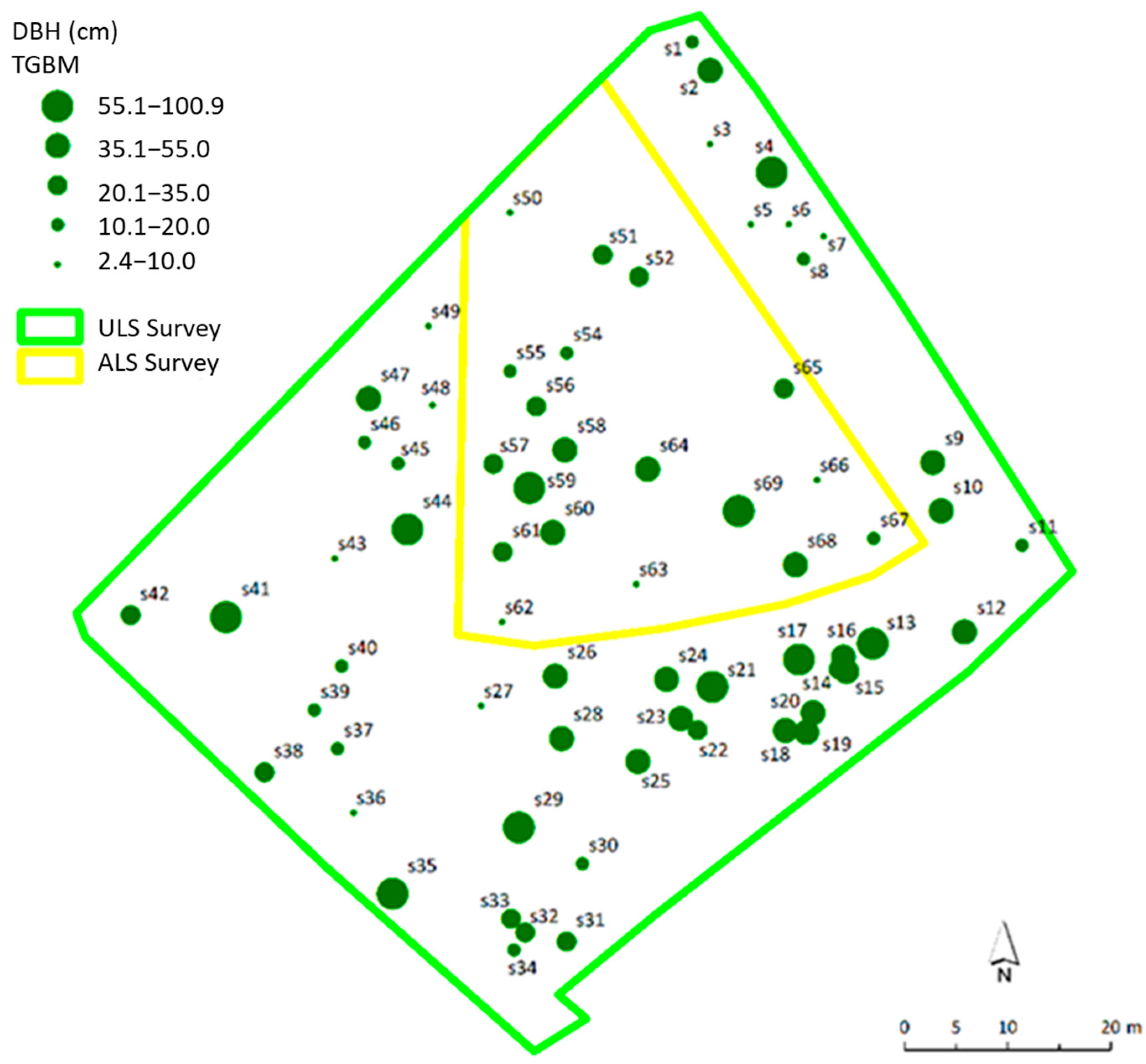

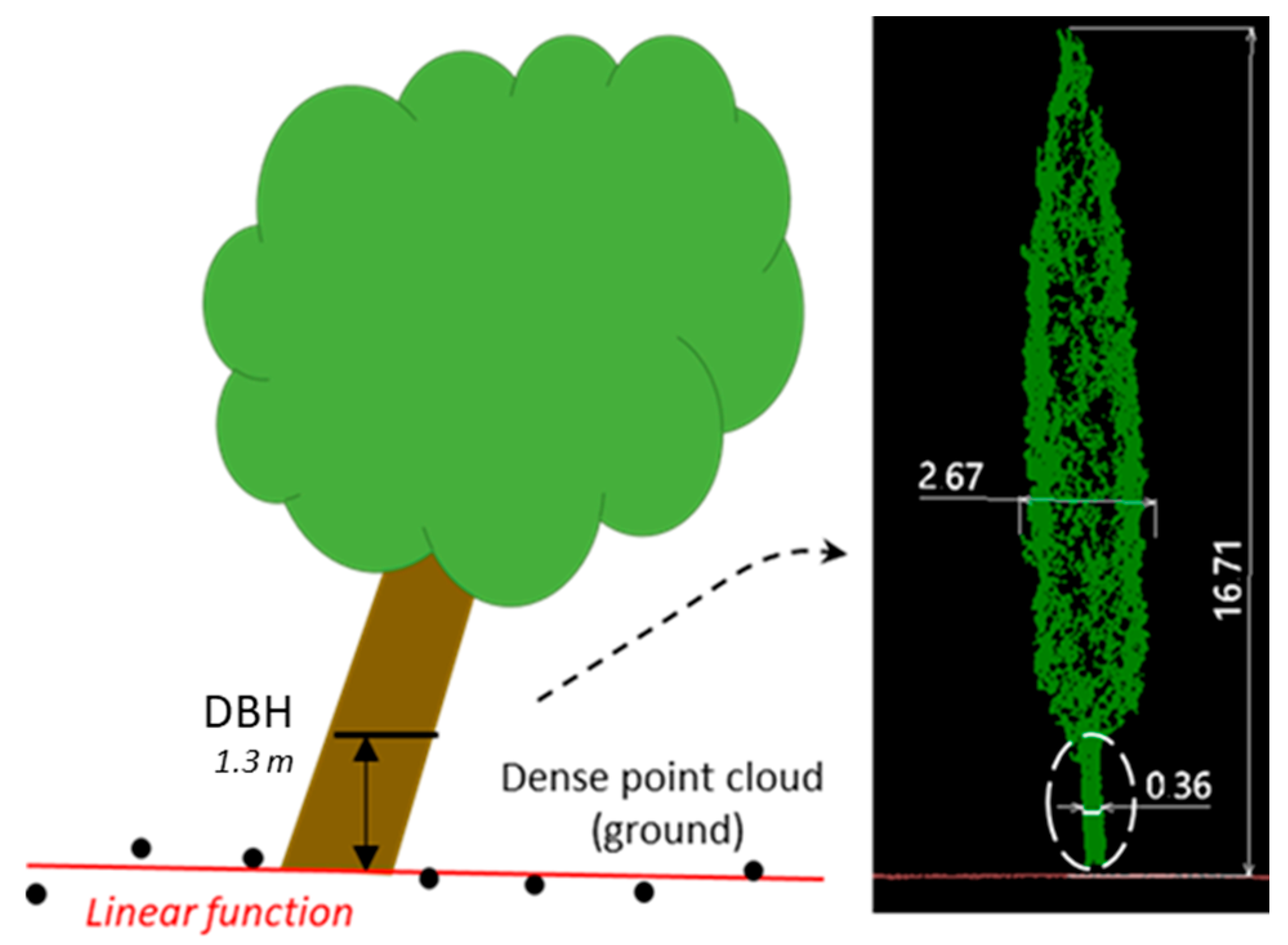
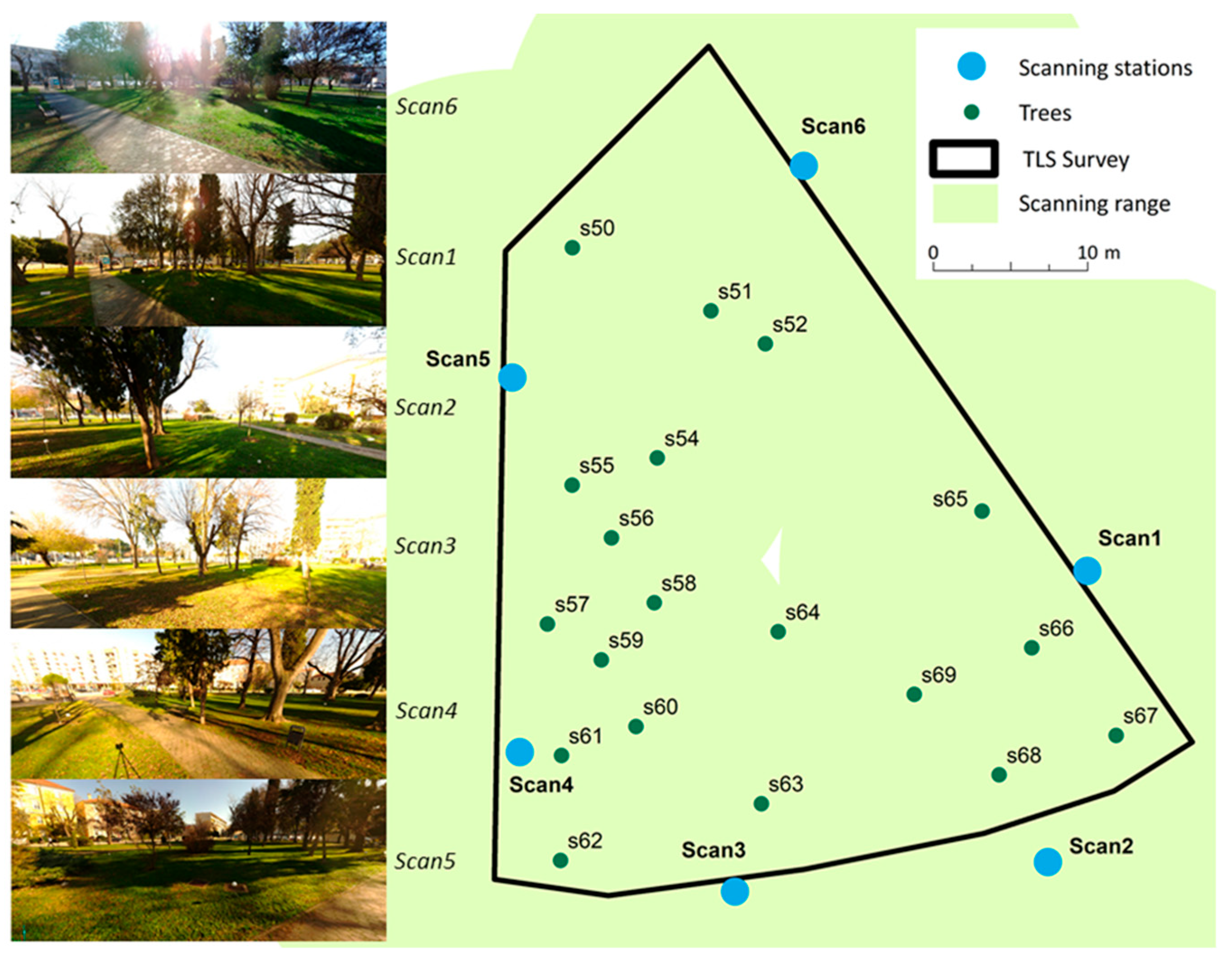
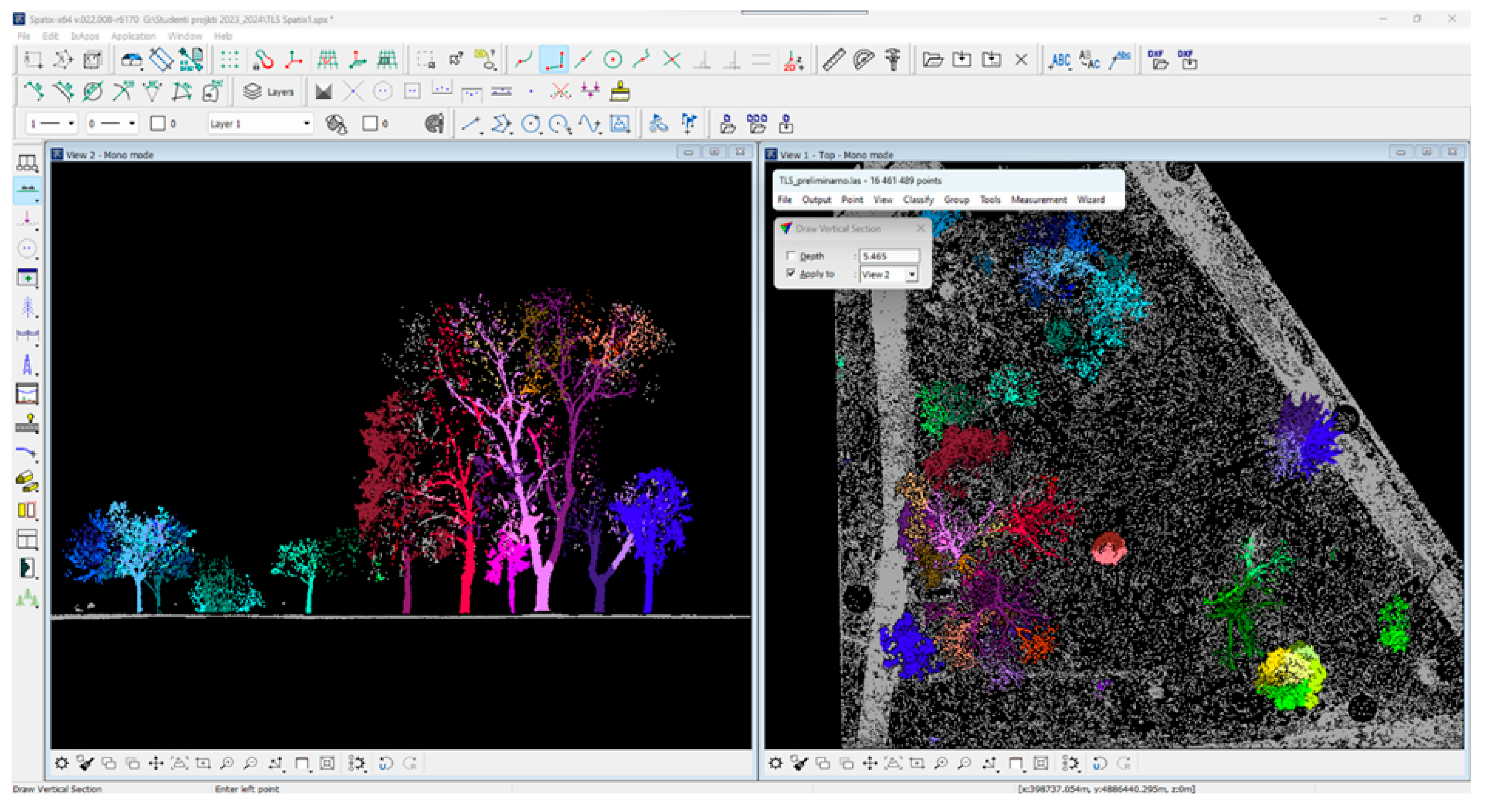

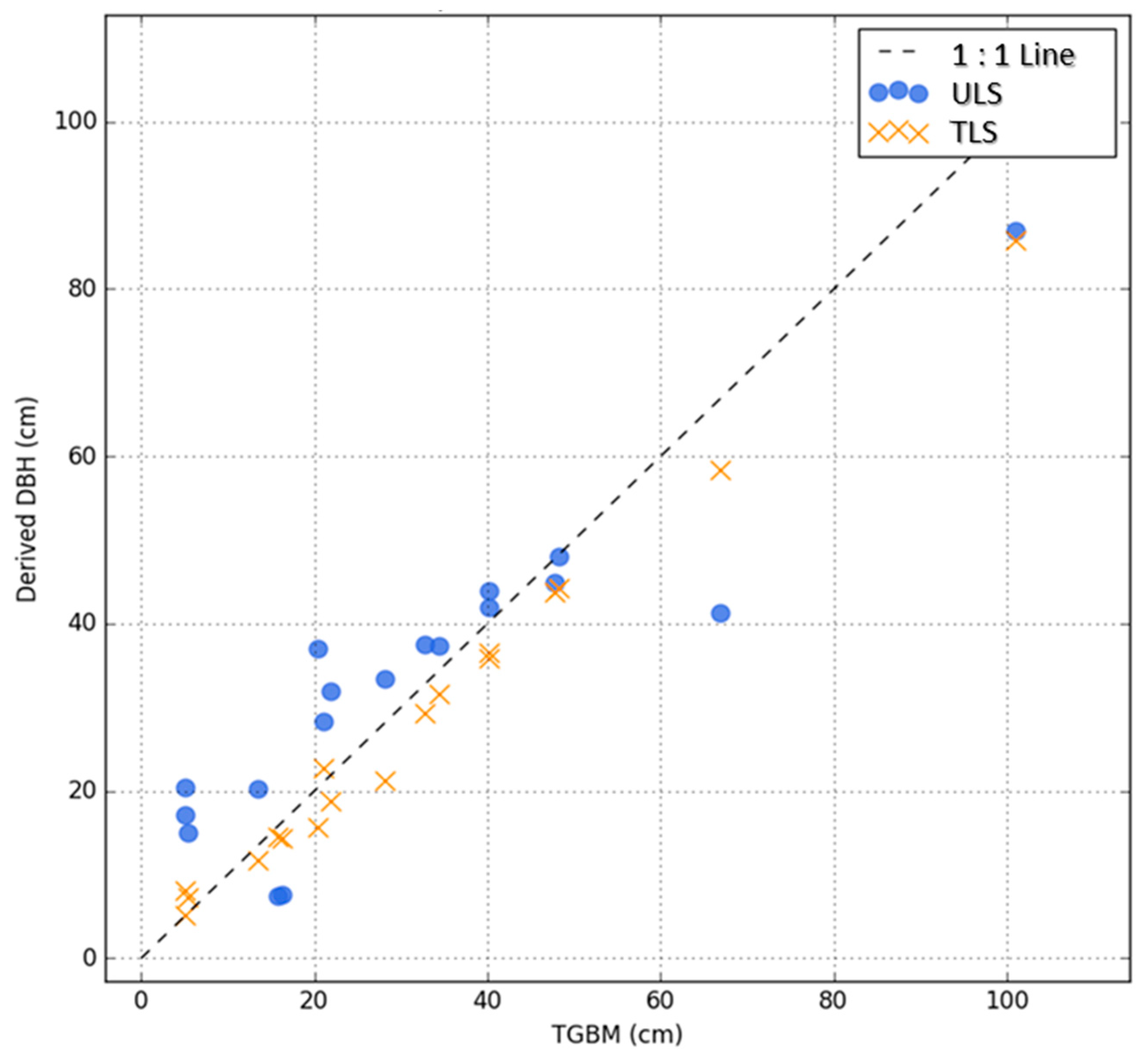
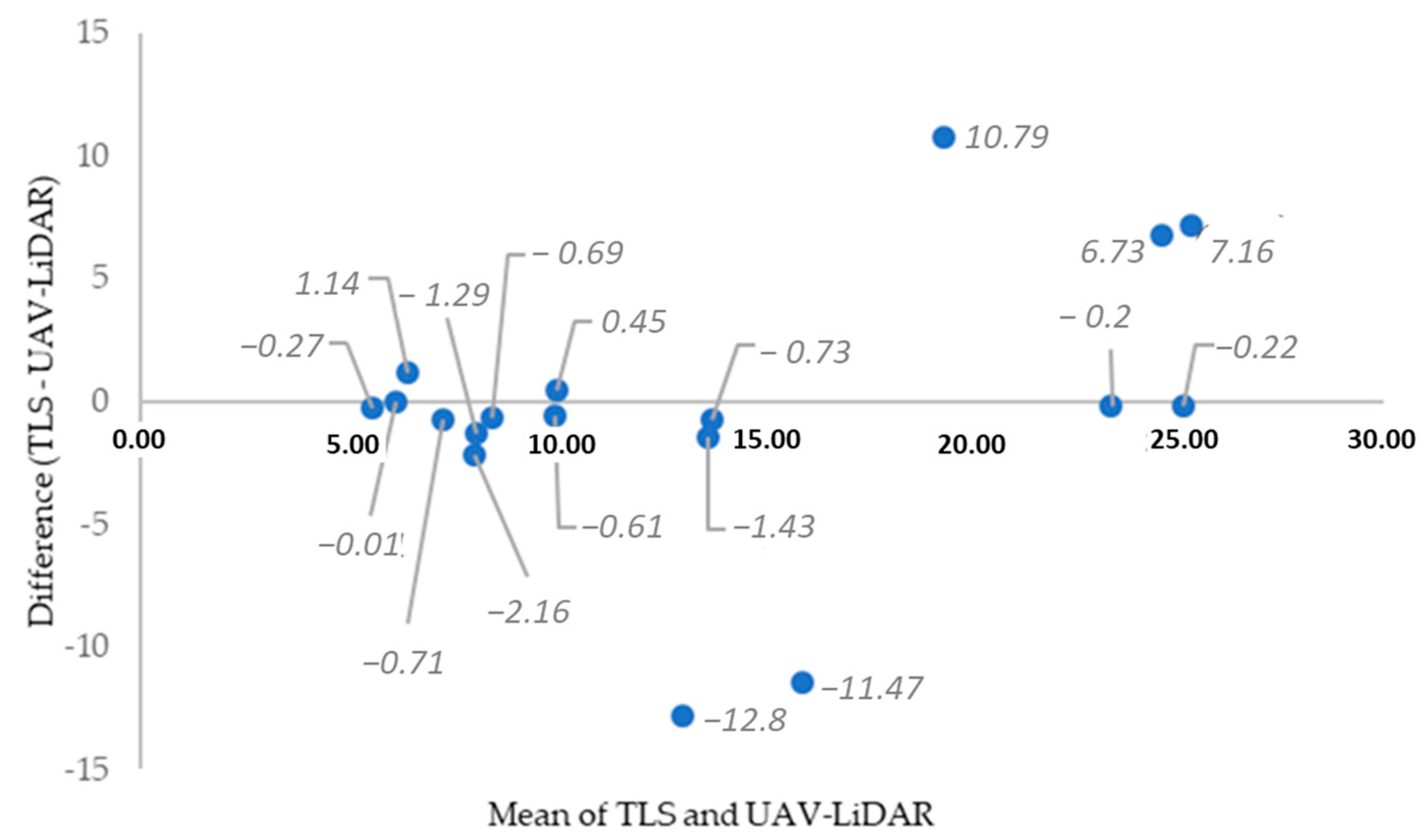
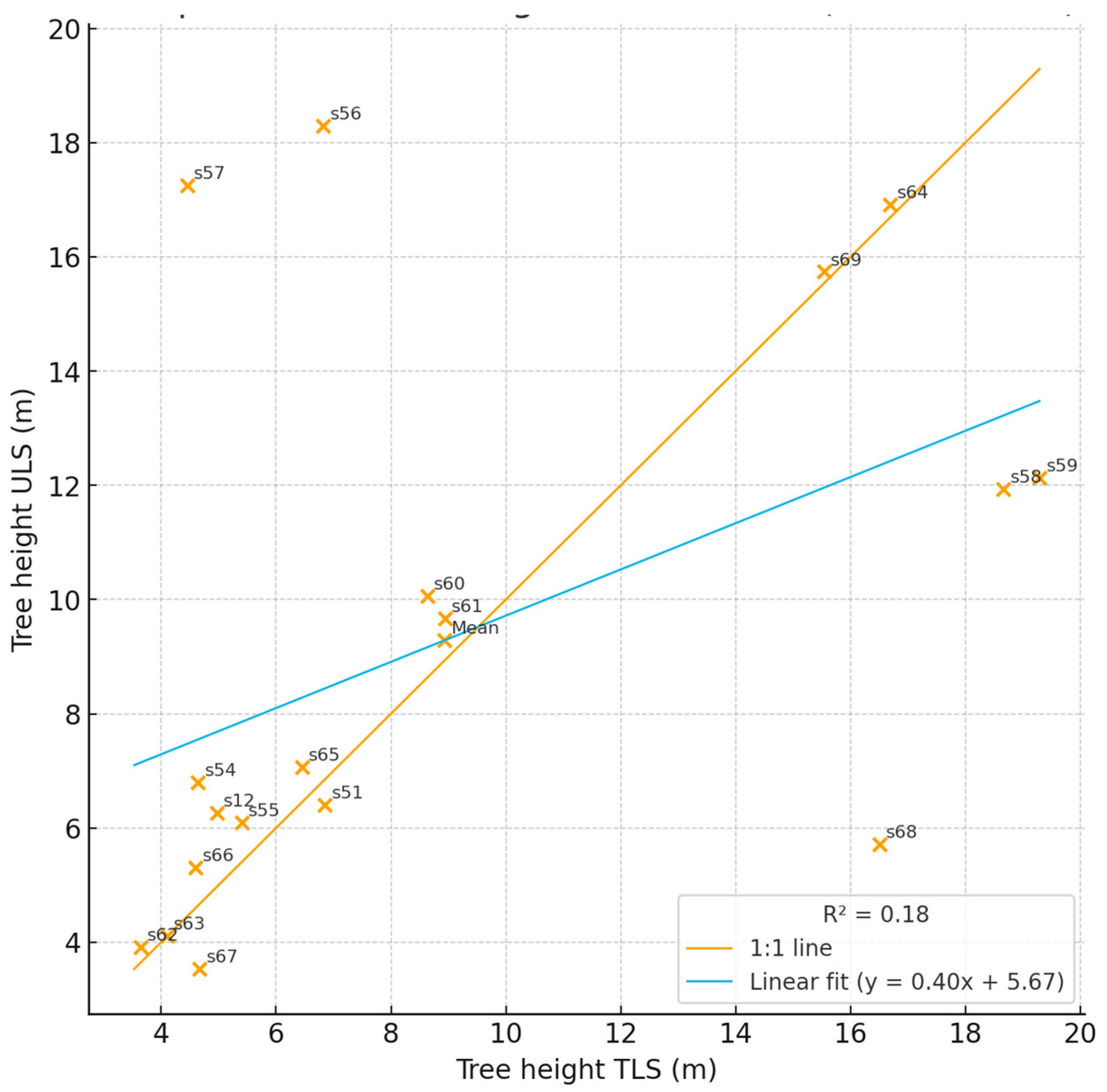
| Scan | Connections | Max. Error (mm) | Mean Error (mm) | Min. Overlap (%) |
|---|---|---|---|---|
| 1 | 1 | 6.8 | 6.8 | 48.1 |
| 2 | 2 | 10.7 | 8.8 | 48.1 |
| 3 | 2 | 10.7 | 8.5 | 48.8 |
| 4 | 2 | 6.3 | 6.1 | 48.8 |
| 5 | 2 | 10.6 | 8.2 | 37.8 |
| 6 | 1 | 10.6 | 10.6 | 37.8 |
| Species | N of Trees | Min (cm) | Max (cm) | Mean (cm) | SD (cm) | |
|---|---|---|---|---|---|---|
| Broadleaved decidious | Acer platanoides L. (2), Celtis australis L. (2), Cercis canadensis L. (3), Crataegus crus-galli L. (1), Gleditsia triacanthos L. (2), Melia azedarach L. (1), Populus × canescens (Aiton) Sm. (1), Robinia pseudacacia L. (6) | 18 | 11.62 | 100.90 | 44.47 | 23.55 |
| Broadleaved evergreen | Laurus nobilis L. (1), Quercus ilex L. (2), Trachycarpus fortunei (Hook.) H.Wendl. (1) | 4 | 14.55 | 67.16 | 34.40 | 20.21 |
| Coniferous | Cupressus sempervirens L. (3), Hesperocyparis arizonica (Greene) Bartel (2) | 5 | 32.79 | 56.34 | 41.38 | 7.94 |
| Total | 27 | 11.62 | 100.90 | 42.41 | 21.32 |
| Software | R | Min Error (cm) | Max Error (cm) | SD (cm) | BIAS (cm) | rBIAS (%) | RMSE (cm) | rRMSE (%) |
|---|---|---|---|---|---|---|---|---|
| Spatix | 0.91 | −25.52 | 14.52 | 9.30 | 0.26 | 0.56 | 9.13 | 20.07 |
| CloudCompare | 0.98 | −6.71 | 11.81 | 4.15 | 3.09 | 7.28 | 5.11 | 12.05 |
| Species | N of Trees | Min (cm) | Max (cm) | Mean (cm) | SD (cm) | |
|---|---|---|---|---|---|---|
| Broadleaved decidious | Amelanchier lamarckii F. G. Schroed.(1), Cercis canadensis L. (5), Crataegus crus-galli L. (1), Melia azedarach L. (1), Populus × canescens (Aiton) Sm. (1), Robinia pseudacacia L. (1), Sorbus aucuparia L. (1), Tilia × europae L. (1) | 12 | 5.10 | 100.90 | 31.24 | 28.28 |
| Broadleaved evergreen | Magnolia virginiana L. (1), Quercus ilex L. (1) | 2 | 20.40 | 34.40 | 27.40 | 7.00 |
| Coniferous | Cupressus sempervirens L. (4) | 4 | 21.00 | 40.10 | 33.50 | 7.81 |
| Total | 18 | 5.10 | 100.90 | 31.31 | 23.56 |
| Data | R | Min Error (cm) | Max Error (cm) | SD (cm) | BIAS (cm) | rBIAS (%) | RMSE (cm) | rRMSE (%) |
|---|---|---|---|---|---|---|---|---|
| ULS | 0.908 | −25.60 | 16.70 | 10.73 | 2.05 | 6.56 | 10.63 | 33.95 |
| TLS | 0.996 | −15.00 | 3.00 | 4.15 | −3.23 | −10.32 | 5.17 | 16.51 |
Disclaimer/Publisher’s Note: The statements, opinions and data contained in all publications are solely those of the individual author(s) and contributor(s) and not of MDPI and/or the editor(s). MDPI and/or the editor(s) disclaim responsibility for any injury to people or property resulting from any ideas, methods, instructions or products referred to in the content. |
© 2025 by the authors. Licensee MDPI, Basel, Switzerland. This article is an open access article distributed under the terms and conditions of the Creative Commons Attribution (CC BY) license (https://creativecommons.org/licenses/by/4.0/).
Share and Cite
Šiljeg, A.; Kolar, K.; Marić, I.; Domazetović, F.; Balenović, I. Comparative Accuracy Assessment of Unmanned and Terrestrial Laser Scanning Systems for Tree Attribute Estimation in an Urban Mediterranean Forest. Remote Sens. 2025, 17, 3557. https://doi.org/10.3390/rs17213557
Šiljeg A, Kolar K, Marić I, Domazetović F, Balenović I. Comparative Accuracy Assessment of Unmanned and Terrestrial Laser Scanning Systems for Tree Attribute Estimation in an Urban Mediterranean Forest. Remote Sensing. 2025; 17(21):3557. https://doi.org/10.3390/rs17213557
Chicago/Turabian StyleŠiljeg, Ante, Katarina Kolar, Ivan Marić, Fran Domazetović, and Ivan Balenović. 2025. "Comparative Accuracy Assessment of Unmanned and Terrestrial Laser Scanning Systems for Tree Attribute Estimation in an Urban Mediterranean Forest" Remote Sensing 17, no. 21: 3557. https://doi.org/10.3390/rs17213557
APA StyleŠiljeg, A., Kolar, K., Marić, I., Domazetović, F., & Balenović, I. (2025). Comparative Accuracy Assessment of Unmanned and Terrestrial Laser Scanning Systems for Tree Attribute Estimation in an Urban Mediterranean Forest. Remote Sensing, 17(21), 3557. https://doi.org/10.3390/rs17213557










